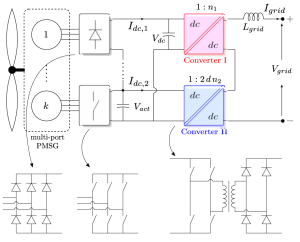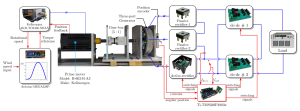DC Grid Interface for Wind Energy Systems
Debranjan Mukherjee with Advisor Dr. Arijit Banerjee
Offshore wind energy conversion systems are getting increased attention due to high and steady wind potential, and minimum environmental effects. As these wind farms are located far from the land (sometimes more than 100km) high power density, reliability, and efficiency are of paramount importance for the generation and the transmission systems. For such systems, high voltage dc (HVDC, in the range of ±500 kV) transmission is preferred over high voltage ac (HVAC) mainly due to the requirement of a large amount of reactive power for HVAC cables. However, the wind generator voltage rating lies in the range of 3.3kV to 10 kV. We have developed an efficient and reliable power converter architecture which enables the low-voltage wind generator to be connected to the HVDC transmission lines. Figure 1 shows the proposed architecture.
The generator ac output is first converted to dc using an integrated generator-rectifier architecture. The most attractive feature of this integrated rectifier is that most of the power is processed by reliable, efficient, and inexpensive diodes operating at the generator frequency. Dc-dc converters are then connected between the rectifier output and the HVDC grid in such a way that the total switch volt-ampere is minimized. This improves reliability, efficiency, and power density. This research is funded by ARPA-E.

